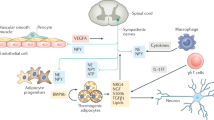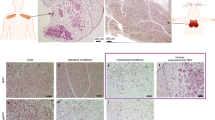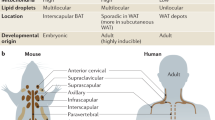Abstract
Brown adipose tissue helps to maintain body temperature in hibernators, rodents and neonatal mammals by converting lipids and glucose into heat, thereby increasing energy expenditure. In addition to classical brown adipocytes, adult rodents—like adult humans—harbour brown-like adipocytes in the predominantly white adipose tissue. The formation of these brite (brown-in-white) adipocytes is a physiological response to chronic cold and their cellular origin is under debate. We show here that cold-induced formation of brite adipocytes in mice is reversed within 5 weeks of warm adaptation, but the brite adipocytes formed by cold stimulation are not eliminated. Genetic tracing and transcriptional characterization of isolated adipocytes demonstrates that they are converted into cells with the morphology and gene expression pattern of white adipocytes. Moreover, these white-typical adipocytes can convert into brite adipocytes on additional cold stimulation. Shifting the balance of this interconversion from the white towards the brite phenotype might provide a new means of counteracting obesity by increasing energy expenditure.
This is a preview of subscription content, access via your institution
Access options
Subscribe to this journal
Receive 12 print issues and online access
$209.00 per year
only $17.42 per issue
Buy this article
- Purchase on Springer Link
- Instant access to full article PDF
Prices may be subject to local taxes which are calculated during checkout






Similar content being viewed by others
Accession codes
References
Lin, C. S. & Klingenberg, M. Isolation of the uncoupling protein from brown adipose tissue mitochondria. FEBS Lett. 113, 299–303 (1980).
Cannon, B., Hedin, A. & Nedergaard, J. Exclusive occurrence of thermogenin antigen in brown adipose tissue. FEBS Lett. 150, 129–132 (1982).
Attie, A. D. & Scherer, P. E. Adipocyte metabolism and obesity. J. Lipid Res. 50 (Suppl), S395–S399 (2009).
Steppan, C. M. et al. The hormone resistin links obesity to diabetes. Nature 409, 307–312 (2001).
MacDougald, O. A., Hwang, C. S., Fan, H. & Lane, M. D. Regulated expression of the obese gene product (leptin) in white adipose tissue and 3T3-L1 adipocytes. Proc. Natl Acad. Sci. USA 92, 9034–9037 (1995).
Cinti, S. The adipose organ. Prostaglandins Leukot. Essent. Fatty Acids 73, 9–15 (2005).
Cannon, B. & Nedergaard, J. Brown adipose tissue: function and physiological significance. Physiol. Rev. 84, 277–359 (2004).
Dawkins, M. J. & Scopes, J. W. Non-shivering thermogenesis and brown adipose tissue in the human new-born infant. Nature 206, 201–202 (1965).
Lean, M. E., James, W. P., Jennings, G. & Trayhurn, P. Brown adipose tissue uncoupling protein content in human infants, children and adults. Clin. Sci. (Lond) 71, 291–297 (1986).
Frontini, A. & Cinti, S. Distribution and development of brown adipocytes in the murine and human adipose organ. Cell Metab. 11, 253–256 (2010).
Huttunen, P., Hirvonen, J. & Kinnula, V. The occurrence of brown adipose tissue in outdoor workers. Eur. J. Appl. Physiol. Occup. Physiol. 46, 339–345 (1981).
Garruti, G. & Ricquier, D. Analysis of uncoupling protein and its mRNA in adipose tissue deposits of adult humans. Int. J. Obes. Relat. Metab. Disord. 16, 383–390 (1992).
Kortelainen, M. L., Pelletier, G., Ricquier, D. & Bukowiecki, L. J. Immunohistochemical detection of human brown adipose tissue uncoupling protein in an autopsy series. J. Histochem. Cytochem. 41, 759–764 (1993).
Hany, T. F. et al. Brown adipose tissue: a factor to consider in symmetrical tracer uptake in the neck and upper chest region. Eur. J. Nucl. Med. Mol. Imaging 29, 1393–1398 (2002).
Zingaretti, M. C. et al. The presence of UCP1 demonstrates that metabolically active adipose tissue in the neck of adult humans truly represents brown adipose tissue. FASEB J. 23, 3113–3120 (2009).
Virtanen, K. A. et al. Functional brown adipose tissue in healthy adults. New Eng. J. Med. 360, 1518–1525 (2009).
Van Marken Lichtenbelt, W. D. et al. Cold-activated brown adipose tissue in healthy men. New Engl. J. Med. 360, 1500–1508 (2009).
Saito, M. et al. High incidence of metabolically active brown adipose tissue in healthy adult humans: effects of cold exposure and adiposity. Diabetes 58, 1526–1531 (2009).
Nedergaard, J. & Cannon, B. The changed metabolic world with human brown adipose tissue: therapeutic visions. Cell Metab. 11, 268–272 (2010).
Cousin, B. et al. Occurrence of brown adipocytes in rat white adipose tissue: molecular and morphological characterization. J. Cell Sci. 103, 931–942 (1992).
Young, P., Arch, J. R. & Ashwell, M. Brown adipose tissue in the parametrial fat pad of the mouse. FEBS Lett. 167, 10–14 (1984).
Petrovic, N. et al. Chronic PPAR{γ} activation of epididymally derived white adipocyte cultures reveals a population of thermogenically competent, UCP1-containing adipocytes molecularly distinct from classical brown adipocytes. J. Biol. Chem. 285, 7153–7164 (2010).
Schulz, T. J. et al. Identification of inducible brown adipocyte progenitors residing in skeletal muscle and white fat. Proc. Natl Acad. Sci. USA 108, 143–148 (2011).
Wu, J. et al. Beige adipocytes are a distinct type of thermogenic fat cell in mouse and human. Cell 150, 366–376 (2012).
Lazar, M. A. Developmental biology. How now, brown fat? Science 321, 1048–1049 (2008).
Xue, B. et al. Genetic variability affects the development of brown adipocytes in white fat but not in interscapular brown fat. J. Lipid Res. 48, 41–51 (2007).
Guerra, C., Koza, R. A., Yamashita, H., Walsh, K. & Kozak, L. P. Emergence of brown adipocytes in white fat in mice is under genetic control. Effects on body weight and adiposity. J. Clin. Invest. 102, 412–420 (1998).
Loncar, D. Convertible adipose tissue in mice. Cell Tissue Res. 266, 149–161 (1991).
Walden, T. B., Hansen, I. R., Timmons, J. A., Cannon, B. & Nedergaard, J. Recruited vs. nonrecruited molecular signatures of brown, ‘brite,’ and white adipose tissues. Am. J. Physiol. Endocrinol. Metab. 302, E19–E31 (2012).
Sharp, L. Z. et al. Human BAT possesses molecular signatures that resemble beige/brite cells. PLoS ONE 7, e49452 (2012).
Gesta, S., Tseng, Y. H. & Kahn, C. R. Developmental origin of fat: tracking obesity to its source. Cell 131, 242–256 (2007).
Cinti, S. Transdifferentiation properties of adipocytes in the Adipose Organ. Am. J. Physiol. Endocrinol. Metab. 297, E977–986 (2009).
Cinti, S. Adipocyte differentiation and transdifferentiation: plasticity of the adipose organ. J. Endocrinol. Invest. 25, 823–835 (2002).
Perwitz, N. et al. Cannabinoid type 1 receptor blockade induces transdifferentiation towards a brown fat phenotype in white adipocytes. Diabetes Obes. Metab. 12, 158–166 (2010).
Virtanen, K. A. & Nuutila, P. Brown adipose tissue in humans. Curr. Opin. Lipidol. 22, 49–54 (2011).
Himms-Hagen, J. et al. Multilocular fat cells in WAT of CL-316243-treated rats derive directly from white adipocytes. Am. J. Physiol. Cell Physiol. 279, C670–C681 (2000).
Vitali, A. et al. The adipose organ of obesity-prone C57BL/6J mice is composed of mixed white and brown adipocytes. J. Lipid Res. 53, 619–629 (2012).
Cristancho, A. G. & Lazar, M. A. Forming functional fat: a growing understanding of adipocyte differentiation. Nat. Rev. Mol. Cell Biol. 12, 722–734 (2011).
Vegiopoulos, A. et al. Cyclooxygenase-2 controls energy homeostasisin mice by de novo recruitment of brown adipocytes. Science 328, 1158–1161 (2010).
Lee, Y. H., Petkova, A. P., Mottillo, E. P. & Granneman, J. G. In vivo identification of bipotential adipocyte progenitors recruited by β3-adrenoceptor activation and high-fat feeding. Cell Metab. 15, 480–491 (2012).
Luche, H., Weber, O., Nageswara Rao, T., Blum, C. & Fehling, H. J. Faithful activation of an extra-bright red fluorescent protein in ‘knock-in’ Cre-reporter mice ideally suited for lineage tracing studies. Eur. J. Immunol. 37, 43–53 (2007).
Enerback, S. et al. Mice lacking mitochondrial uncoupling protein are cold-sensitive but not obese. Nature 387, 90–94 (1997).
Lowell, B. B. et al. Development of obesity in transgenic mice after genetic ablation of brown adipose tissue. Nature 366, 740–742 (1993).
Nobusue, H., Endo, T. & Kano, K. Establishment of a preadipocyte cell line derived from mature adipocytes of GFP transgenic mice and formation of adipose tissue. Cell Tissue Res. 332, 435–446 (2008).
Sun, K., Kusminski, C. M. & Scherer, P. E. Adipose tissue remodeling and obesity. J. Clin. Invest. 121, 2094–2101 (2011).
Cinti, S. et al. Adipocyte death defines macrophage localization and function in adipose tissue of obese mice and humans. J. Lipid Res. 46, 2347–2355 (2005).
Seale, P. et al. PRDM16 controls a brown fat/skeletal muscle switch. Nature 454, 961–967 (2008).
Sanchez-Gurmaches, J. et al. PTEN loss in the Myf5 lineage redistributes body fat and reveals subsets of white adipocytes that arise from Myf5 precursors. Cell Metab. 16, 348–362 (2012).
Jimenez, M. et al. β3-adrenoceptor knockout in C57BL/6J mice depresses the occurrence of brown adipocytes in white fat. Eur. J. Biochem. 270, 699–705 (2003).
Nguyen, K. D. et al. Alternatively activated macrophages produce catecholamines to sustain adaptive thermogenesis. Nature 480, 104–108 (2011).
Rodeheffer, M. S., Birsoy, K. & Friedman, J. M. Identification of white adipocyte progenitor cells in vivo. Cell 135, 240–249 (2008).
Berry, R. & Rodeheffer, M. S. Characterization of the adipocyte cellular lineage in vivo. Nat. Cell Biol. 15, 302–308 (2013).
Moulin, K. et al. Emergence during development of the white-adipocyte cell phenotype is independent of the brown-adipocyte cell phenotype. Biochem. J. 356, 659–664 (2001).
Rothwell, N. J. & Stock, M. J. Luxuskonsumption, diet-induced thermogenesis and brown fat: the case in favour. Clin. Sci. (Lond) 64, 19–23 (1983).
Astrup, A., Bulow, J., Madsen, J. & Christensen, N. J. Contribution of BAT and skeletal muscle to thermogenesis induced by ephedrine in man. Am. J. Physiol. 248, E507–E515 (1985).
Johansson, T. et al. Building a zoo of mice for genetic analyses: a comprehensive protocol for the rapid generation of BAC transgenic mice. Genesis 48, 264–280 (2010).
Rulicke, T. Pronuclear microinjection of mouse zygotes. Methods Mol. Biol. 254, 165–194 (2004).
Rodriguez, C. I. et al. High-efficiency deleter mice show that FLPe is an alternative to Cre-loxP. Nat. Genet. 25, 139–140 (2000).
Lamprecht, M. R., Sabatini, D. M. & Carpenter, A. E. CellProfiler: free,versatile software for automated biological image analysis. Biotechniques 42, 71–75 (2007).
Meissburger, B., Stachorski, L., Roder, E., Rudofsky, G. & Wolfrum, C. Tissue inhibitor of matrix metalloproteinase 1 (TIMP1) controls adipogenesis in obesity in mice and in humans. Diabetologia 54, 1468–1479 (2011).
Schneider, C. A., Rasband, W. S. & Eliceiri, K. W. NIH Image to ImageJ: 25 years of image analysis. Nat. Methods 9, 671–675 (2012).
Acknowledgements
M.R. was supported by a Boehringer Ingelheim Fonds PhD Fellowship. This study received financial support from the Austrian Genome Research Programme GEN-AU II and III (T.R.), the ERC, the SNF and FP7 DIABAT (C.W.).
We thank Cornelius Fischer (Flow Cytometry Facility, UNIZH) for providing FACS sortings, E. Weber for cryosectioning and M. Stoffel, M. Kopf and N. Beaton for reviewing the manuscript.
Author information
Authors and Affiliations
Contributions
M.R. and C.W. designed the study and wrote the paper, M.R. performed most of the experiments, A.P. established and performed adipocyte sortings, and T.R. provided oocyte injections for transgenic animals.
Corresponding author
Ethics declarations
Competing interests
The authors declare no competing financial interests.
Supplementary information
Supplementary Information
Supplementary Information (PDF 1100 kb)
Supplementary Table 1
Supplementary Information (XLS 45 kb)
Supplementary Table 2
Supplementary Information (XLS 78 kb)
Rights and permissions
About this article
Cite this article
Rosenwald, M., Perdikari, A., Rülicke, T. et al. Bi-directional interconversion of brite and white adipocytes. Nat Cell Biol 15, 659–667 (2013). https://doi.org/10.1038/ncb2740
Received:
Accepted:
Published:
Issue Date:
DOI: https://doi.org/10.1038/ncb2740
This article is cited by
-
Deep learning enables the quantification of browning capacity of human adipose samples
Journal of Big Data (2024)
-
Integrated gene expression profiles reveal a transcriptomic network underlying the thermogenic response in adipose tissue
Scientific Reports (2023)
-
Genetically prolonged beige fat in male mice confers long-lasting metabolic health
Nature Communications (2023)
-
Age-dependent Pdgfrβ signaling drives adipocyte progenitor dysfunction to alter the beige adipogenic niche in male mice
Nature Communications (2023)
-
Fuelling the fire: de novo lipogenesis primes thermogenesis
Nature Metabolism (2023)



